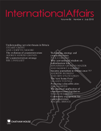-
Views
-
Cite
Cite
Malise Ruthven, The eleventh of September and the Sudanese mahdiya in the context of Ibn Khaldun's theory of Islamic history, International Affairs, Volume 78, Issue 2, April 2002, Pages 339–351, https://doi.org/10.1111/1468-2346.00254
Close - Share Icon Share
Abstract
The attacks on New York and Washington on 11 September appeared as something entirely new in the escalating terrorist ‘War on America’ declared by Osama bin Laden and his Al-Qa'ida network in 1998. While there are undoubtedly novel elements in the atrocity which cost nearly 3,000 innocent, non-combatant lives, the strategic motivation of the attack, aimed at the protectors of the ruling Saudi dynasty, was not inconsistent with earlier patterns of Islamic revolt against Muslim governments and their European backers, notably the Sudanese mahdiya of 1881–99. Though spearheaded by technically sophisticated Islamist ideologues, the overwhelming presence among the hijackers of Saudis from the Asir region, with its Yemeni tribal links, is indicative of a pre-modern pattern of rebellion that fits in with the paradigm of cyclical revolt and dynastic renewal discerned by the Islamic philosopher of history Ibn Khaldun (1332–1406).





